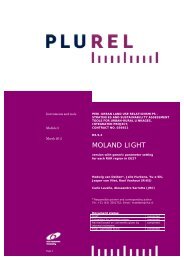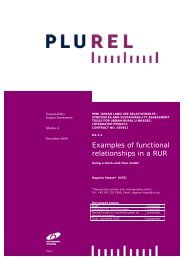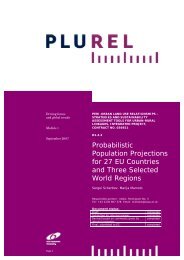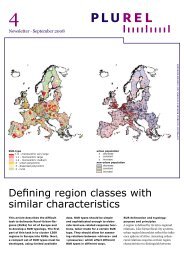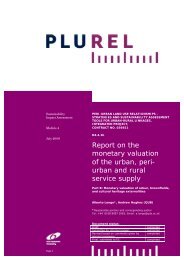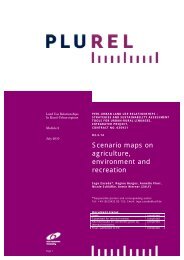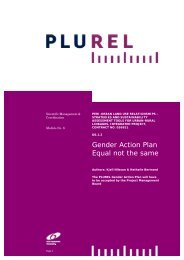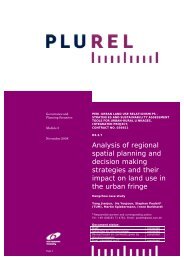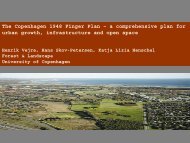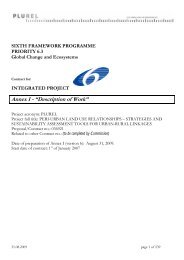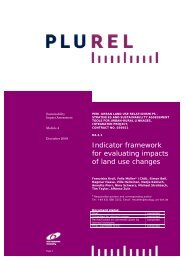Cost benefit analysis of peri-urban land use policy - Plurel
Cost benefit analysis of peri-urban land use policy - Plurel
Cost benefit analysis of peri-urban land use policy - Plurel
Create successful ePaper yourself
Turn your PDF publications into a flip-book with our unique Google optimized e-Paper software.
The average ho<strong>use</strong> price in the <strong>policy</strong> site was obtained by using the data <strong>of</strong> actual ho<strong>use</strong><br />
transactions, including flats and ho<strong>use</strong>s, between year 2007 and year 2009. We firstly<br />
adjusted ho<strong>use</strong> prices in 2007€ and 2008€ to 2009€ by using the Slovenian housing price<br />
indexes. The average sale price <strong>of</strong> a ho<strong>use</strong> between 2007 and 2009 is obtained by taking the<br />
weighted average <strong>of</strong> the annual average sale values by their corresponding annual numbers <strong>of</strong><br />
transactions. It is the same to derive the average price <strong>of</strong> a flat. The estimated average sale<br />
prices are 119,273 (2009€) for a flat and 211,690 (2009€) for a ho<strong>use</strong>.<br />
The population density, population/km 2 , in the study site was obtained for the Multnomah<br />
County in Oregon, USA, at the 1990 level, i.e.1406/ km 2 (USCensus, 1990). The population<br />
density for the <strong>policy</strong> site is 104/km 2 in the region <strong>of</strong> Obalno-kraška, at the 2008 level<br />
(Statistics <strong>of</strong>fice <strong>of</strong> the Republic <strong>of</strong> Slovenia, 2010). Obalno-kraška is the region in which the<br />
<strong>policy</strong> site is located.<br />
Using all these values, the proximity premium was estimated at 943,214 – 1,939,845€<br />
(2009€).<br />
Climate regulating service <strong>of</strong> the golf course<br />
This study considered the carbon capacity <strong>of</strong> a golf course. Several types <strong>of</strong> vegetation can be<br />
found on a typical golf course and the majority <strong>of</strong> the area is grass<strong>land</strong>s.<br />
An 18-hole golf course usually takes up 50-60 hectares <strong>of</strong> <strong>land</strong>. In the case <strong>of</strong> the <strong>policy</strong> site,<br />
the grass<strong>land</strong>s <strong>of</strong> the golf course can be converted from any <strong>of</strong> the three previous <strong>land</strong> <strong>use</strong>s –<br />
agricultural <strong>land</strong>, forest and private settlement; however, the researchers do not have detailed<br />
information about the exact size to be converted from each <strong>of</strong> the three types <strong>of</strong> <strong>land</strong>s to the<br />
course. Hence, we have to make the following assumptions: 1) the grass<strong>land</strong>s <strong>of</strong> the golf<br />
course are 60 hectares (maximum); 2) these <strong>land</strong>s will be converted from agricultural <strong>land</strong> or<br />
forest. According to Conant et al. (2001), the capacity <strong>of</strong> carbon sequestration <strong>of</strong> temperate<br />
grass<strong>land</strong>s around the world ranges from 0.35 tC/ha/year 8 (if conversation from native<br />
vegetation to grass<strong>land</strong>, hence ‘forest’ in our <strong>policy</strong> site) to 1.01 tC/ha/yr 9 (if conversation<br />
from arable to permanent grass<strong>land</strong>, hence ‘vineyard’ in our <strong>policy</strong> site). Note these values can<br />
vary with climate, grass<strong>land</strong> management, and other factors which, however, are not<br />
accounted for in this study.<br />
8 1.25 tCO 2 /ha/year<br />
9 3.70 tCO 2 /ha/year<br />
Page 19 • PLUREL report No 4.4.3 • December 2010



